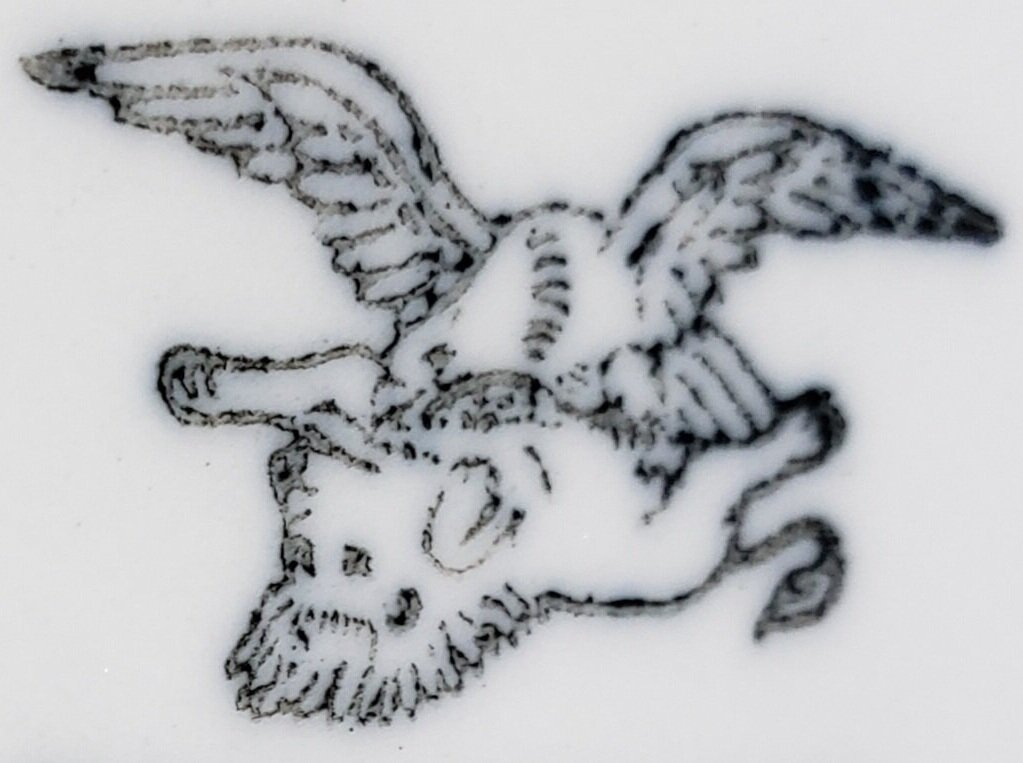
Pottery Marks and Their Evolution
Early (late 18th and early 19th Century) American pottery was made for utilitarian needs. Potteries concentrated on cook ware, but not dinner ware and sanitary ware. but not decorative ware. Utilitarian ware did not need a trademark. It was considered to be everyday, household ware; meant to be well-used and not “seen” by those entering the home. Occasionally a potter’s mark, often consisting of initials, was incised in the bottom of a piece but rarely was there a stamped mark.
As potteries in America became more dominant and more plentiful, there became a need to differentiate who made the item.
Only a few potteries in the mid-19th century marked their ware with a mark that could be attributed to a specific pottery. The star mark incised in the teapot to the left does not indicate who made the pot. Rockingham and yellowware products were often left unmarked, only attributable to a certain pottery if there was an oral tradition attached to the mark and item.
Pottery marks developed over time and their use reflects the growth and establishment of the American industry. Early marks pull heavily on English pottery marks or British themes. This was done to fool purchasers into thinking they had purchased a foreign piece of ware during a time when American ware was considered inferior. These British appearing American marks occasionally included the pottery’s name but almost never the location of the pottery.
As pottery production transitioned from Rockingham and yellowware to whiteware, ironstone, and other white-based wares, so did the need for attributing the product to specific manufacturers. Whitewares were stronger, more durable but also were less utilitarian in nature and more likely to be “seen” in the home. Many potteries continued to make utilitarian ware as they transitioned to tableware, some continuing to manufacture sanitary and household wares well into the early 20th century.
Unattributed mark stamped in the bottom of a Rockingham teapot
East End Pottery Company
Laughlin Brothers c. 1877
Cartwright Brothers c. 1887
The early mark to the left is an example of an American mark that gives no credit to the American pottery that manufactured it. The British themes and the word “Royal” were designed to “fool” American purchasers that they were purchasing English (foreign) manufactured goods. This was especially true of ware made on the Ohio frontier. New Jersey potteries, closer to the eastern markets, has a slightly easier time selling wares on the East Coast. For Ohio Valley potters, the markets were west, south and north along the inland waterways, canals and railways.
However, early Ohio potters were skilled pottery workers from the English pottery strongholds of Staffordshire and Derbyshire. These men, seeking a prosperous future, were progressive in their development of, and vision in. the future of American made pottery.
English manufacturers were not unaware of the attempts at deception by American ceramic manufacturers. In, The East Liverpool, Ohio Pottery District Identification of Manufacturers Marks (2009) William Gates quotes a caution from John Maddock and Sons, an English manufacturer, in their 1894 price list as stating, “this stamp is being imitated. It is easier to imitate the stamp than the goods.” American potteries were, however, making their marks in the industry.
The Centennial Celebration in 1876 and the 1893 World’s Fair saw the emergence and acceptance of American china products when the submitted ware won top prizes for quality and beauty. Emboldened by success, American potteries, through the last quarter of the 19th century, began to transition the marks from British themes to American patriotic themes. This included themes of American domination (in the pottery industry) over its British and European competition. The most famous of these marks can be seen here, on the left. The Laughlin Brothers Pottery in 1877 produced a mark where the American Eagle was devouring the English Lion, an open challenge signifying the emerging dominance of American china.
Other marks would be more patriotic than victorious, such as the Vodrey and Brother Pottery mark on the right. Note that these transitional marks now attribute the location of the pottery as either being produced in an American town or the U.S.A. The motifs and themes would transition once more toward the end of the 19th century and the first quarter of the 20th century. By then, there is full attribution of who and where the products were manufactured. The confidence to add city or town and country to the marks was a symbol of their success. World War I contributed to solidifying the market for American ceramics when European products were not available.
WJA
Vodrey and Brother c. 1876
William Brunt Pottery c. 1892
C. C. Thompson Company c. 1927
Homer Laughlin China Company c. 1907
Bibliography:
Gates, William C, and Dana E Ormerod. The East Liverpool, Ohio Pottery District Identification of Manufacturers and
Marks. California, PA: Society for Historical Archaeology, 2009.







